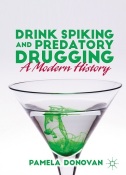
This is an excerpt from my book, Drink Spiking and Predatory Drugging: A Modern History, (pages 94-95). In reflecting on the particular version of dystopia depicted in Brave New World, Huxley surprised his audience a little.
[note: I also recommend an animated recording of a Mike Wallace interview with Huxley, courtesy of BoingBoing, which elaborates his view that technology is morally neutral, but its social uptake never is.]
In 1956, a Manhattan conference was convened to consider the state of therapeutic psychopharmacology. Among the speakers was Aldous Huxley, famously author of the 1932 book Brave New World, but at that time more recently, The Doors of Perception (1954). He predicted in his talk that a bevy of new consciousness-altering drugs was nigh, and that society should in some way be prepared to have its foundations rocked. Ethics and religion would be subject to greater scrutiny, he said, in an age when our minds can be fundamentally transformed on demand.(18) Coming from the author of Brave New World, which casts a rather dim light on the potential totalitarian, technocratic becalming of populations, this was somewhat startling. His endorsement of the peaceful mind that might emerge from the use of meprobamate [Miltown – a common tranquilizer] was quite explicit—he was a fan.(19)
One of the other parts of Huxley’s life story is his foray into consciousness-tweaking drug experimentation. Huxley was one of the original psychonauts, having made a foray into mescaline use. Like many of his generation, he may have been actually optimistic about pharma technology and human evolution. Soma-bad-Miltown-and-mescaline-good is probably not the way he saw it. Rather, the knowledge is here, the drugs are coming—what do we do with this? Some of the distance between Brave New World and The Doors of Perception can simply be credited to his evolving views on a matter he clearly thought about a great deal. It could also be that he was asking a question—meprobamate seemed to be doing many people some genuine good, but what of the big picture? —without answering it.
Some of the discordance about Huxley’s positive views on the tranquilizer revolution only seems sharp from the vantage point of our current dominant cultural messages. Huxley represented a true transitional figure in this regard. The War on Drugs in the USA, beginning in 1981, which reverberated globally, came with some fairly monolithic mantras: drugs are bad and just say no. Aimed, of course, at substances already made illicit, it also affected how we thought about the drugs that we are permitted, and maybe even at times, encouraged to take. Andrea Tone documents a significant emerging negative view of tranquilizers in the late 1970s that was shared by specific groups all across the political spectrum. “Americans,” she notes, “were for the first time politically unnerved by their prescription behavior.”(20)
Yet there was only a temporary dip in actual use; mostly, the tranquilizer continued its journey onward and upward. We have taken benzodiazepines in record numbers, yet we mix up no Xanax cocktails and create no Ativan artwork. There is widespread adoption but little open celebration. Simply put, we do not talk about it. Once the medical model of anxiety and acute stress became hegemonic, in the 1980s, it privatized worry about Worry.
Only the strictly sober, we might assume, would see all kinds of mind alteration as inherently suspicious. This turns out not to be the case—some of the most suspicious were the new drug-takers themselves.
[this passage continues in a discussion of LSD and its early advocates in the chapter “Baby, its Cold War Outside” (chapter 4)]
Notes
18 “‘Behavior’ Drugs Now Envisioned; Aldous Huxley Predicts They Will Bring Re-Examining of Ethics and Religion,” New York Times, October 19, 1956. Via New York Times Archive.
19 and 20 Tone, 62–64.